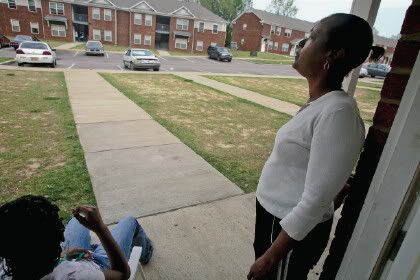Delaying That Dialog On Race
 Are we ready for that national dialog on race yet? If and when we start it, can we put on the required reading list Hanna Rosin's American Murder Mystery from The Atlantic
Are we ready for that national dialog on race yet? If and when we start it, can we put on the required reading list Hanna Rosin's American Murder Mystery from The AtlanticThe story turns on the rising crime rate in mid-sized cities (500,000 to 1 million population) -- a stat that's counter to the flat crime rates in the big cities. In Memphis TN, for example, the violent crime rate's been rising at 20 percent annually.
And it didn't take too long before a hint of a topic for the national dialog on race began to form up:
Memphis has always been associated with some amount of violence. But why has Elvis’s hometown turned into America’s new South Bronx? [Police Lt. Doug] Barnes thinks he knows one big part of the answer, as does the city’s chief of police. A handful of local criminologists and social scientists think they can explain it, too. But it’s a dismal answer, one that city leaders have made clear they don’t want to hear. It’s an answer that offers up racial stereotypes to fearful whites in a city trying to move beyond racial tensions. Ultimately, it reaches beyond crime and implicates one of the most ambitious antipoverty programs of recent decades.It is, of course, that the crime wave has a black engine -- and because Memphis politicians need the black vote, they would rather stick their heads in the sand. Good idea; a gunshot wound to the buttocks is less life-threatening than one to the head.
The story behind the Memphis stats is fascinating, so I'll pull a rather long quote from the story:
The process of tearing down the projects and moving the (primarily black) residents to more affluent (primarily white) neighborhoods started carefully; in fact, no projects were torn down. Fewer than 200 families were picked for relocation and screened to find the motivate families with fewer than five children. Not surprisingly, the results were very good -- more kids finishing school, families rising out of poverty.About five years ago, [criminologist Richard] Janikowski embarked on a more ambitious project. He’d built up enough trust with the police to get them to send him daily crime and arrest reports, including addresses and types of crime. He began mapping all violent and property crimes, block by block, across the city. “These cops on the streets were saying that crime patterns are changing,” he said, so he wanted to look into it.
When his map was complete, a clear if strangely shaped pattern emerged: Wait a minute, he recalled thinking. I see this bunny rabbit coming up. People are going to accuse me of being on shrooms! The inner city, where crime used to be concentrated, was now clean. But everywhere else looked much worse: arrests had skyrocketed along two corridors north and west of the central city (the bunny rabbit’s ears) and along one in the southeast (the tail). Hot spots had proliferated since the mid-1990s, and little islands of crime had sprung up where none had existed before, dotting the map all around the city.
Janikowski might not have managed to pinpoint the cause of this pattern if he hadn’t been married to Phyllis Betts, a housing expert at the University of Memphis. Betts and Janikowski have two dogs, three cats, and no kids; they both tend to bring their work home with them. Betts had been evaluating the impact of one of the city government’s most ambitious initiatives: the demolition of the city’s public-housing projects, as part of a nationwide experiment to free the poor from the destructive effects of concentrated poverty. Memphis demolished its first project in 1997. The city gave former residents federal “Section8” rent-subsidy vouchers and encouraged them to move out to new neighborhoods. Two more waves of demolition followed over the next nine years, dispersing tens of thousands of poor people into the wider metro community.
If police departments are usually stingy with their information, housing departments are even more so. Getting addresses of Section 8 holders is difficult, because the departments want to protect the residents’ privacy. Betts, however, helps the city track where the former residents of public housing have moved. Over time, she and Janikowski realized that they were doing their fieldwork in the same neighborhoods.
About six months ago, they decided to put a hunch to the test. Janikowski merged his computer map of crime patterns with Betts’s map of Section8 rentals. Where Janikowski saw a bunny rabbit, Betts saw a sideways horseshoe (“He has a better imagination,” she said). Otherwise, the match was near-perfect. On the merged map, dense violent-crime areas are shaded dark blue, and Section8 addresses are represented by little red dots. All of the dark-blue areas are covered in little red dots, like bursts of gunfire. The rest of the city has almost no dots.
Betts remembers her discomfort as she looked at the map. The couple had been musing about the connection for months, but they were amazed—and deflated—to see how perfectly the two data sets fit together. She knew right away that this would be a “hard thing to say or write.” Nobody in the antipoverty community and nobody in city leadership was going to welcome the news that the noble experiment that they’d been engaged in for the past decade had been bringing the city down, in ways they’d never expected. But the connection was too obvious to ignore, and Betts and Janikowski figured that the same thing must be happening all around the country.
Also not surprisingly, the media leaped on it, turning the resulting ACLU book, Waiting for Gautreaux, into the prophetic tome of leftist social meddling.
And not surprisingly, given the impatience of the left, what followed was the wholesale destruction of housing projects and accompanying relocation of all their residents -- not just the motivated, relatively low childbirth ones.
And finally, not surprisingly at all, what followed was bunny rabbits in Memphis. Memphis is now the fourth most violent mid-sized city in America, and think demolition of housing projects when you consider the three ranked worse, from third to first: Baltimore, Washington DC, Detroit. (Rosin found other stats that placed Memphis "at the very top.")
How did the leaders of Memphis respond to the data? Predictably, not well:
Earlier this year, Betts presented her findings to city leaders, including Robert Lipscomb, the head of the Memphis Housing Authority. From what Lipscomb said to me, he’s still not moved. “You’ve already marginalized people and told them they have to move out,” he told me irritably, just as he’s told Betts. “Now you’re saying they moved somewhere else and created all these problems? That’s a really, really unfair assessment. You’re putting a big burden on people who have been too burdened already, and to me that’s, quote-unquote, criminal.”To Lipscomb, it's the data -- the reality -- that's criminal, not the splashes of red throughout the bunny's ears. It's the studies of black behavior that is criminal, not the behavior of blacks.
Is America ready for a dialog on race?
Of course, housing -- whether the projects of old or the suburban Section 8 apartments of today -- isn't the problem. Neither is race, per se.
My mother-in-law owned several apartments in Redding CA and did all she could not to rent to Section 8 renters -- who were mostly white or Hispanic there -- because they simply were more destructive and problematic than routine renters. Part of the Memphis crime problem is the result of the welfare, statist society the Left has succeeded in building in America.
And certainly, the uniquely black propensity to out of wedlock birth -- another residue of the ravages statism has caused in the black community -- has a lot to do with it. Rosin never mentions this in her article. Rather, she dwells on the difficulty project residents have getting acclimated to new neighborhoods, particularly those who weren't motivated to leave the projects, and ignores the fact that the families she writes about are mom and kid families, not mom and dad and kid families.
This is almost a taboo subject among liberals. For example, when recent stats on unwed births came out, the NYT trumpeted it as good news:
The birth rate for unmarried black women, long a focal point in the debate over the causes of poverty among African-Americans, has reached its lowest point in 40 years, Federal health officials said today.
According to figures compiled by the National Center for Health Statistics, there were 74.4 births per 1,000 unmarried black women in 1996 -- the last year for which complete data are available. That rate is significantly below the peak of 90.7 per 1,000 unmarried black women reached in 1989.
Buried 12 paragraphs down was the stat that the unwed birthrate among non-Hispanic whites was a still shocking but comparatively minuscule 21.5 percent.
hat-tip: Jim




<< Home